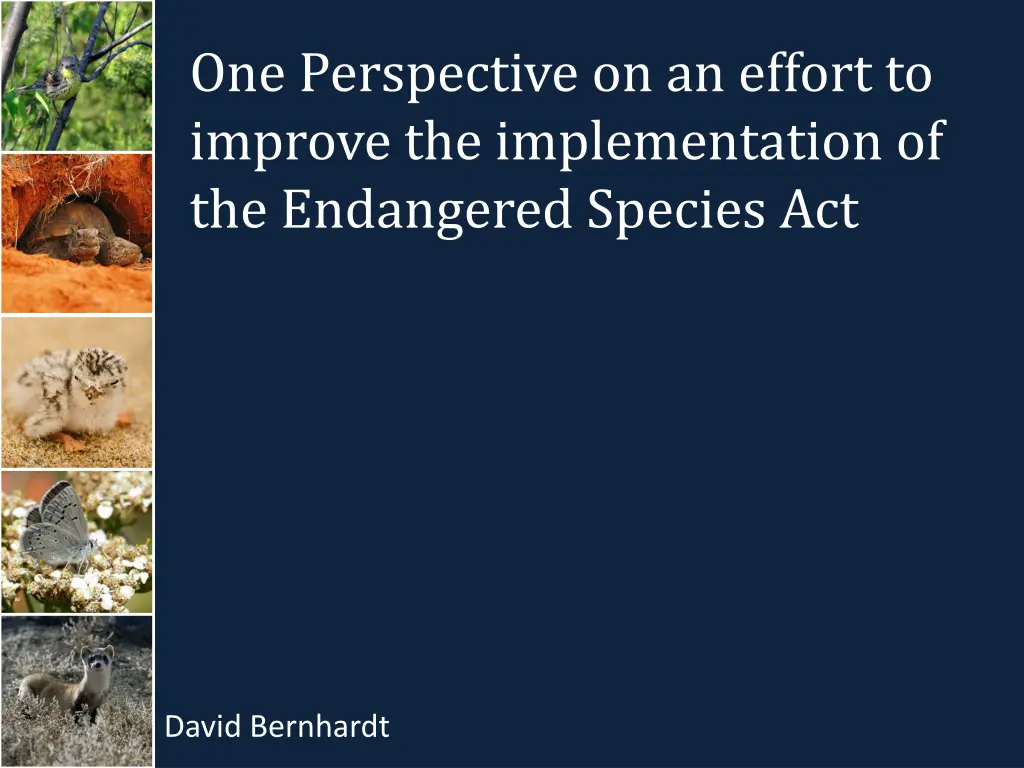
Perspective on Improving Endangered Species Act Implementation
Explore a detailed perspective on improving the implementation of the Endangered Species Act, focusing on decision-making, statutory factors, and the application of discretion and judgement. Insights on regulatory mechanisms, conservation practices, and the determination of threatened species are highlighted, aiming for an optimal outcome in law and policy.
Download Presentation

Please find below an Image/Link to download the presentation.
The content on the website is provided AS IS for your information and personal use only. It may not be sold, licensed, or shared on other websites without obtaining consent from the author. If you encounter any issues during the download, it is possible that the publisher has removed the file from their server.
You are allowed to download the files provided on this website for personal or commercial use, subject to the condition that they are used lawfully. All files are the property of their respective owners.
The content on the website is provided AS IS for your information and personal use only. It may not be sold, licensed, or shared on other websites without obtaining consent from the author.
E N D
Presentation Transcript
One Perspective on an effort to improve the implementation of the Endangered Species Act David Bernhardt
Decision-making in Context Law Policy Facts/Data Discretion/Judgement
Statute 4(a)(1) says [t]he Secretary shall by regulation promulgated in accordance with subsection (b) determine whether any species is an endangered species or a threatened species because of any of the following factors: (A) the present or threatened destruction, modification, or curtailment of its habitat or range; (B) overutilization for commercial, recreational, scientific, or educational purposes; (C) disease or predation; (D) the inadequacy of existing regulatory mechanisms; or (E) other natural or manmade factors affecting its continued existence.
Statute Identified basis for decision Determination must be: [solely on the basis of the best scientific and commercial data available to him after conducting a review of the status of the species and after taking into account those efforts, if any, being made by any State or foreign nation, or any political subdivision of a State or foreign nation, to protect such species, whether by predator control, protection of habitat and food supply, or other conservation practices, within any area under its jurisdiction, or on the high seas
Application of Statute requires application of Discretion/ Judgement The term threatened species means any species which is likely to become an endangered species within the foreseeable future throughout all or a significant portion of its range.
Optimal Outcome Law Policy Facts/Data Discretion/Judgement
Highlights of Joint Endangered Species Act Proposed Revisions to the Regulations --Full Presentation Available at www.fws.gov
Background Section 4 of the Act Provides for how to add and remove species from the Federal lists of threatened and endangered species Provides procedures for designating critical habitat Implementing regulations are at 50 CFR 424 Addresses protective regulations for threatened species (i.e., 4(d) rules) Section 7 of the Act Provides requirements for Federal agency cooperation and consultation procedures Implementing regulations are at 50 CFR 402 Section 9 of the Act Establishes prohibitions for listed species Implementing regulations are at 50 CFR 17
Proposed Changes to 50 CFR 424 Listing, Delisting, or Reclassifying species Creates a regulatory framework for the phrase foreseeable future Clarifies that the standard for listing and delisting of species is the same Removes reference to economic or other impacts in classification decisions
Proposed Changes to 50 CFR 424 Criteria for Designating Critical Habitat Clarifies when designation of critical habitat may not be prudent Revises the process and standards for designation of unoccupied critical habitat
Proposed Changes -- 50 CFR 402 The proposed revisions would: Address alternative consultation mechanisms Revise the definitions of destruction or adverse modification and effects of the action Address certainty of mitigation proposed by action agencies Seeks comment on mechanisms that might further improve the consultation process
My Perspective Expect we will get a great many other ideas in comments Took decades of experience between two agencies and asked regarding section 4 and 7 what can be improved. Best practices adopted (FWS special 4(d) rules) Innovative ideas put forward (new approaches to consultation reductions in paperwork) Effort to provide greater defeasibility, clarity and reduce unnecessary burdens Specifically asking for broad range of commentary and other ideas Better conservation outcomes and less conflict mean resources have greater focus on collaboration
Comment on or before September 24, 2018 Questions?
